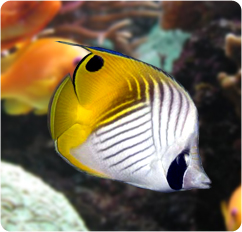Marine Inverts - Banded Coral Shrimp (Stenopus hispidus)
The Banded Coral Shrimp catches the eyes of most aquarists with their lovely coloration and body form. it's hanging red and white bands across its body with fairly long pinchers and additional long white antennae. Combined with its prickly body texture, this peaceful member of the Stenopodidae family brings interest to any marine marine museum. However, most hobbyists praise Stenopus hispidus for its active nature because it scampers round the marine museum in search of food.
Interestingly, members of the Stenopodidae family ar referred to as "Boxing Shrimp" due to the big pinchers on their third set of legs. These pinchers ar usually control erect and provides the Banded Coral Shrimp the looks of a boxer able to fight. tho' the Banded Coral Shrimp may be aggressive towards alternative Banded Coral Shrimp and smaller shrimp of various species, most ar peaceful towards fish, corals, and invertebrates inside your marine museum. due to its aggressive disposition towards alternative Banded Coral Shrimp, the Banded Coral Shrimp ought to be housed singly or unbroken as a real mated combine.
Native to the oceans of Indonesia, Stenopus hispidus is maybe the foremost cosmopolitan shrimp within the ocean. it always hangs turned in caves or crevices, with solely its antennae rising from the opening. whereas molt, the Banded Coral Shrimp can usually hide from sight for 1-2 days within the rocks of the reef. within the home marine museum, offer enough space for the Banded Coral Shrimp therefore it will move regarding freely while not its long antennae touching neighboring corals or anemones.
Interestingly, members of the Stenopodidae family ar referred to as "Boxing Shrimp" due to the big pinchers on their third set of legs. These pinchers ar usually control erect and provides the Banded Coral Shrimp the looks of a boxer able to fight. tho' the Banded Coral Shrimp may be aggressive towards alternative Banded Coral Shrimp and smaller shrimp of various species, most ar peaceful towards fish, corals, and invertebrates inside your marine museum. due to its aggressive disposition towards alternative Banded Coral Shrimp, the Banded Coral Shrimp ought to be housed singly or unbroken as a real mated combine.
Native to the oceans of Indonesia, Stenopus hispidus is maybe the foremost cosmopolitan shrimp within the ocean. it always hangs turned in caves or crevices, with solely its antennae rising from the opening. whereas molt, the Banded Coral Shrimp can usually hide from sight for 1-2 days within the rocks of the reef. within the home marine museum, offer enough space for the Banded Coral Shrimp therefore it will move regarding freely while not its long antennae touching neighboring corals or anemones.
The Banded Coral Shrimp is comparatively hardy associated boasts an aquarium-suited length that seldom exceeds three inches, six inches with the antennae. The male Banded Coral Shrimp is sometimes smaller. Breeding the Banded Coral Shrimp is sometimes not made. Larvae typically succumb to filtration and skimming.
Like alternative invertebrates, the Banded Coral Shrimp is impatient of high nitrate or copper levels. take care to take care of correct iodine levels within the marine museum to assist guarantee correct molt. The Banded Coral Shrimp should be acclimated slowly to avoid any salinity and/or pH scale shock.
In the wild, the Banded Coral Shrimp may be a scavenger. within the home marine museum, it'll settle for most flaked and frozen foods.
Approximate Purchase Size: 3/4" to 2-1/2" Pair: 3/4" to 2-1/2"
key: freshwater fish, freshwater tropical fish, exotic freshwater fish, salt water fish tank, tropical fish, tropical fish store, flying fish, flying fish little rock, fly fishing, fish recipes, easy fish recipes, fish recipe, healthy fish recipes, grilled fish recipes, fish batter recipe, fish chowder recipe, white fish recipes, fishing games, bass fishing, bass fish, bass fishiing tips








